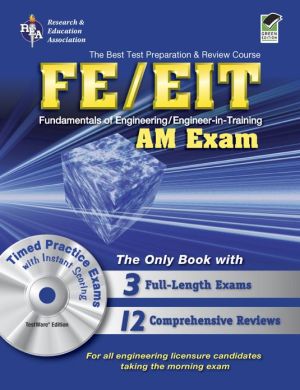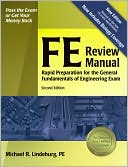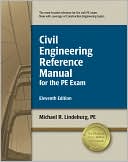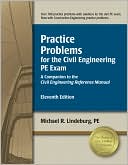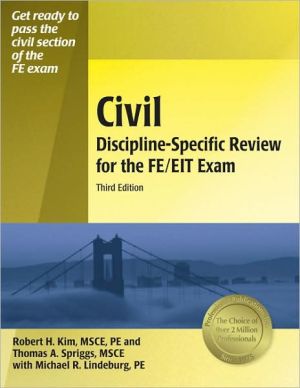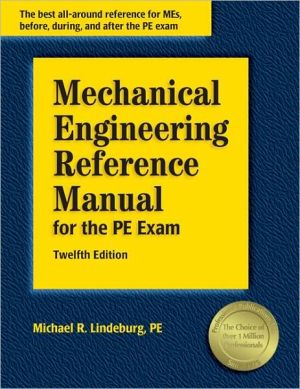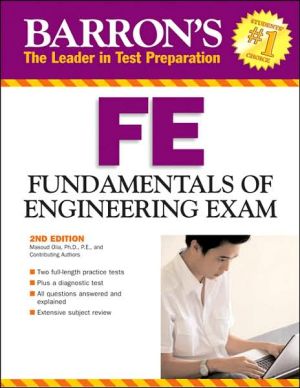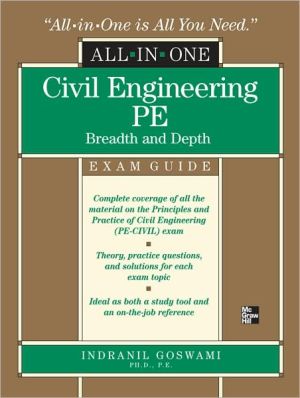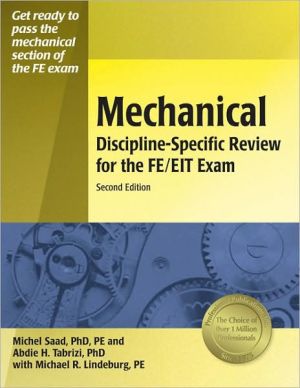FE/EIT AM w/CD-ROM (REA) - The Best Test Prep for the Engineer in Training Exam
The ONLY book with 3 full-length, 4-hour exams, plus 12 comprehensive reviews for the AM portion of the FE(EIT). Step-by-step explanations are presented. Knowledge of the first 90 semester credit hours of a typical engineering program are tested. Thorough reviews are provided for all areas tested on the FE, including the two new sections, Computers and Ethics. For engineering students who are pursuing an 'Engineer-in- Training' certification.
Search in google:
The ONLY book with 3 full-length, 4-hour exams, plus 12 comprehensive reviews for the AM portion of the FE(EIT). Step-by-step explanations are presented. Knowledge of the first 90 semester credit hours of a typical engineering program are tested. Thorough reviews are provided for all areas tested on the FE, including the two new sections, Computers and Ethics. For engineering students who are pursuing an 'Engineer-in- Training' certification.
You Can Succeed on the FE: AM EXAM\ By reviewing and studying this book, you can succeed on the Fundamentals of Engineering Examination Morning Session. The entire FE Exam is an eight-hour, supplied-reference exam split into AM and PM sessions lasting four hours apiece; the morning session is common to all engineering disciplines, while the afternoon session is offered in five disciplines. Because the FE was formerly known as the EIT (Engineer-in-Training) Exam, many aspiring engineers know it today as the "FE/EIT."\ The purpose of REA's The Best Test Preparation & Review Course for the FE: AM Exam is to prepare you sufficiently for the morning portion of the FE Exam. Our book does this by providing you with 12 review chapters-each of which includes sample problems-and three full-length practice tests. Our review chapters and practice tests have been crafted by experts on the FE to reflect the scope and difficulty level of the actual FE: AM Exam. In accordance with the move by the National Council of Examiners for Engineering and Surveying (NCEES) to all-metric AM exams, we have gone all-metric (with the necessary exception of a few problems). You'll find that our topical reviews are rich in examples that feature thorough, step-by-step solutions. REA's practice tests enable you to completely simulate the FE test-taking experience while providing the added value of detailed explanations for every answer. While availing yourself of either the reviews or the practice tests alone would surely be helpful, we strongly recommend using the two approaches in tandem.\ About our Authors In order to provide review material for you that properly captures all subjects and subtopics covered on the actual FE: AM Exam, every chapter in this book has been carefully prepared by text experts in various fields of engineering. Our authors and editorial review board have thoroughly examined and researched the mechanics of the FE: AM Exam to ensure that our book is accurate, calibrated to the correct difficulty level, and relevant to the FE-from start to finish. Our experts, most of whom are P.E.'s and Ph.D.'s, have been widely published and are highly regarded both within and outside academia, holding positions at leading U.S. colleges and universities and in private industry.\ About the Test The Fundamentals of Engineering Exam is one part in the four-step process toward becoming a professional engineer (P.E.). It is administered by NCEES and is offered twice a year, on Saturdays in April and October. Graduating from an approved four-year engineering program and passing the FE qualifies you for certification as an Engineer-in-Training or an Engineer Intern. The final two steps towards licensing as a P.E. involve completion of four years of additional engineering experience and passing the Principles and Practices of Engineering (PE) Examination, which NCEES also administers. Registration as a professional engineer is deemed both highly rewarding and beneficial in the engineering community.\ To register for the FE, contact your state's Board of Examiners for Professional Engineers and Land Surveyors. To find the licensing board in your state and to get information on the exams, contact NCEES:\ National Council of Examiners for Engineering and Surveying P.O. Box 1686\ Clemson, SC 29633-1686\ Phone: (800) 250-3196\ Website: http://www.ncees.org\ Test Format The FE features two distinct sections. One section, the FE: AM, is given in the morning while the other, the FE: PM, is administered in the afternoon. This book will prepare you for the FE: AM Exam.\ The FE: AM is a supplied-reference exam, so candidates are not permitted to bring reference material into the test center. Instead, you will be mailed a reference guide when you register for the exam. You can also view, at no charge, the entire up-to-date FE Supplied-Reference Handbook at the NCEES Website. (Each FE Exam will be administered using the latest edition of the handbook. You can count on your FE handbook review being considerably enhanced by study of our subject reviews and completion of our model tests.) You can also be assured that the NCEES guide will provide all the charts, graphs, tables, and formulae you will need. The same book will be given to you when you sit for the test.\ You will have four hours to complete the AM portion of the exam. It consists of 120 questions spanning 12 engineering subjects:\ Subject Approximate No. of Problems Mathematics 18\ Probability and Statistics 8\ Chemistry 11\ Computers 8\ Ethics and Business Practices 8\ Engineering Economics 10\ Statics and Dynamics (Engineering Mechanics) 12\ Strength of Materials 8\ Material Properties 8\ Fluid Mechanics 8\ Electricity and Magnetism 11\ Thermodynamics 8\ While thoroughly detailed, our topical reviews lay out the facts for you clearly and cogently. Each chapter begins with a short introduction and then progresses to the specifics of the topics. Each topic is completely explained, using example problems, diagrams, charts, and formulae.\ You may wish to take some of the practice exams at various stages in your studying to gauge your strengths and weaknesses. This will help you determine which topics you need to study more. Take one practice test when you finish studying so that you can see how much you have improved. For studying suggestions that will help you to make the best use of your time, see the Study Schedule presented on page xii.\ Test Sections For studying purposes, the FE: AM can be broken down further into engineering topics. Your registration booklet will explain the breakdown and list the subtopics included under each major heading.\ Overall, there will be 12 different topics on the FE: AM Exam. The following is a summary of the topics that may be included on the exam, along with the types of related questions.\ Mathematics Analytic geometry Integral calculus Matrix operations Roots of equations Vector analysis Differential equations Differential calculus Probability and Statistics Measures of central tendencies and dispersions (mean, mode)\ Probability distributions Conditional probabilities Estimation for a single mean Regression and curve fitting Expected value in decision-making Hypothesis testing Chemistry Nomenclature Oxidation and reduction Periodic table States of matter Acids and bases Equations Equilibrium Metals and nonmetals Computers Terminology (types of memory, baud rates, Internet)\ Spreadsheets Structured programming Ethics and Business Practices Code of ethics Agreement and contracts Ethical versus legal Professional liability Public protection issues Engineering Economics Discounted cash flow Cost (incremental, average, estimating)\ Analyses Uncertainty (expected value and risk)\ Statics and Dynamics Area moments of inertia Frames and trusses Centroid of area Equilibrium of rigid bodies Resultants of force systems Concurrent force systems Linear motion (force, mass, acceleration, momentum)\ Angular motion (torque, inertia, acceleration, momentum)\ Mass moments of inertia Friction Strength of Materials Shear and moment diagrams Stress types Stress strain Deformations Combined stresses Columns Indeterminant analysis Plastic versus elastic deformation Material Properties Properties (chemical, electrical, mechanical, physical)\ Corrosion mechanisms and control Materials (engineered, ferrous, nonferrous)\ Fluid Mechanics Energy, impulse, and momentum equations Fluid statics Fluid properties Flow measurement Pipe and other internal flow Electricity and Magnetism Charge, energy, current, voltage, power Force between charges Current and voltage laws AC circuits Capacitance and inductance Equivalent circuits (series, parallel)\ Reactance and impedance, susceptance and admittance Thermodynamics Thermodynamic laws Cycles Gas mixtures Phase changes Heat transfer Energy, heat, and work Availability and reversibility Ideal gases Properties of enthalpy and enthropy\ Scoring the Exam Your FE: AM score is based upon the number of correct answers you choose. Each of the 120 questions is worth 1 point, and no points are subtracted for incorrect answers. A single score between 0 and 100 is given for the entire test (both AM and PM sections), and both sections are weighted equally. The grade given is on a pass/fail basis. The breakpoint between passing and failing varies from state to state, although 70 is a general reference point for passing. Thus, the general reference point for passing the FE: AM section alone would be 35.\ The pass/fail margin is not a percentage of correct answers or a percentage of students who scored lower than you. This number fluctuates from year to year and is reestablished with every test administration. It is based on previous exam administrations and relates your score to those of previous FE examinees.
Independent Study Schedule xiInstalling REA's TEST ware[Registered] ivYou Can Succeed on the FE: AM Exam 1About Our Authors 4About the Test 4Test Format 4FE: AM Subject Distribution 5Test Sections 6Scoring the Exam 8Test-Taking Strategies 9How to Study for the FE: AM Exam 11Mathematics 17Algebra 19Trigonometry 21Linear Algebra 23Vector Analysis 30Analytical Geometry 35Differential Calculus 37Integration 42Differential Equations 56Laplace Transforms 64Statistics 68Review Problems 79Electrical Circuits 89DC Circuits 91Current Flow 91Electric and Magnetic Fields 102Capacitance and Inductance 112Transients 120AC Circuits 130Power 136Three-Phase Circuits 139Ideal Transformers 145Fourier Transforms in Circuits 147Laplace Transforms in Electric Circuits 150Operational Amplifiers 153Diodes 159Review Problems 178Statics 197Vector Forces 199Moments and Couples 203Two-Dimensional Equilibrium 204Three-Dimensional Equilibrium 206Analysis of Internal Forces 209Distributed Forces, Centroids, and Centers of Gravity 213Friction 216Moments of Inertia 220Review Problems 221Dynamics 239Kinematics 241Kinetics 261Vibrations 291Review Problems 293Mechanics of Materials 305Stress and Strain 307Shear 309Tension and Compression 311Beams 312Bending Moment Diagram 319Torsion 322Columns 324Combined Stresses 326Thin-Walled Pressure Vessels 330Combined Stresses - Load Combinations 333Review Problems 335Chemistry 359Nomenclature 361Equations 363Stoichiometry 365States of Matter 368Solutions 374Periodicity 379Equilibrium 383Acids and Bases 387Oxidation-Reduction 391Electrochemistry 395Kinetics 400Orders of Reactions 405Metals and Nonmetals 406Organic Chemistry 408Inorganic Chemistry 416Review Problems 418Computers 431Flowcharts 433Pseudocode 440Data Storage and Transmission 449Spreadsheets 476Review Problems 483Thermodynamics 491Properties 493Phase Change 496Thermodynamic Processes 502Ideal Gases 503Energy, Heat, and Work 509Availability-lrreversibility 523Cycles 526Air Conditioning and Refrigeration 539Combustion and Chemical Reactions 544Heat Transfer 549Gas Dynamics: Flow Through Nozzles and Blade Passages 553Review Problems 557Fluids 593Fluid Properties 595Fluid Statics 599Hydraulics and Fluid Machines 606Momentum 612Dimensional Analysis and Similitude 615Pipe Flow and Channel Flow 620Flow Measurement 628External Flow 631Compressible Flow 637Review Problems 642Material Science/Structure of Matter 653Materials and Their Atomic Structure 656Structures and Structural Defects of Materials 666Properties of Materials 676Multicomponent Materials and Phase Diagrams 687Diffusion and Reactions in Materials 692Corrosion and Radiation Damage 694Radiation Alteration of Materials 696Composite Materials 697Review Problems 698Engineering Economics 705Investment 707Time Value of Money 708Inflation 710Taxes 710Risk 711Cash Flow 711Interest Factors 713Minimum Attractive Rate of Return (MARR) 717Methods of Project Analysis 717Profitability Analysis 722Equivalence 729Taxes and Depreciation 730Sensitivity Analysis 737Risk Analysis 738Review Problems 742Ethics 751Engineering Ethics 753National Society of Professional Engineers Board of Ethical Review 753NSPE Code of Ethics for Engineers 754Cases and Judgements 761Engineers' Creed 787Moral Vision and the Landscape of Engineering Professionalism 787Review Problems 794Practice Test 1 803Test 1 805Answer Key 843Detailed Explanations of Answers 844Practice Test 2 907Test 2 909Answer Key 948Detailed Explanations of Answers 949Practice Test 3 1001Test 3 1003Answer Key 1039Detailed Explanations of Answers 1040Answer Sheets 1093Appendix 1101
